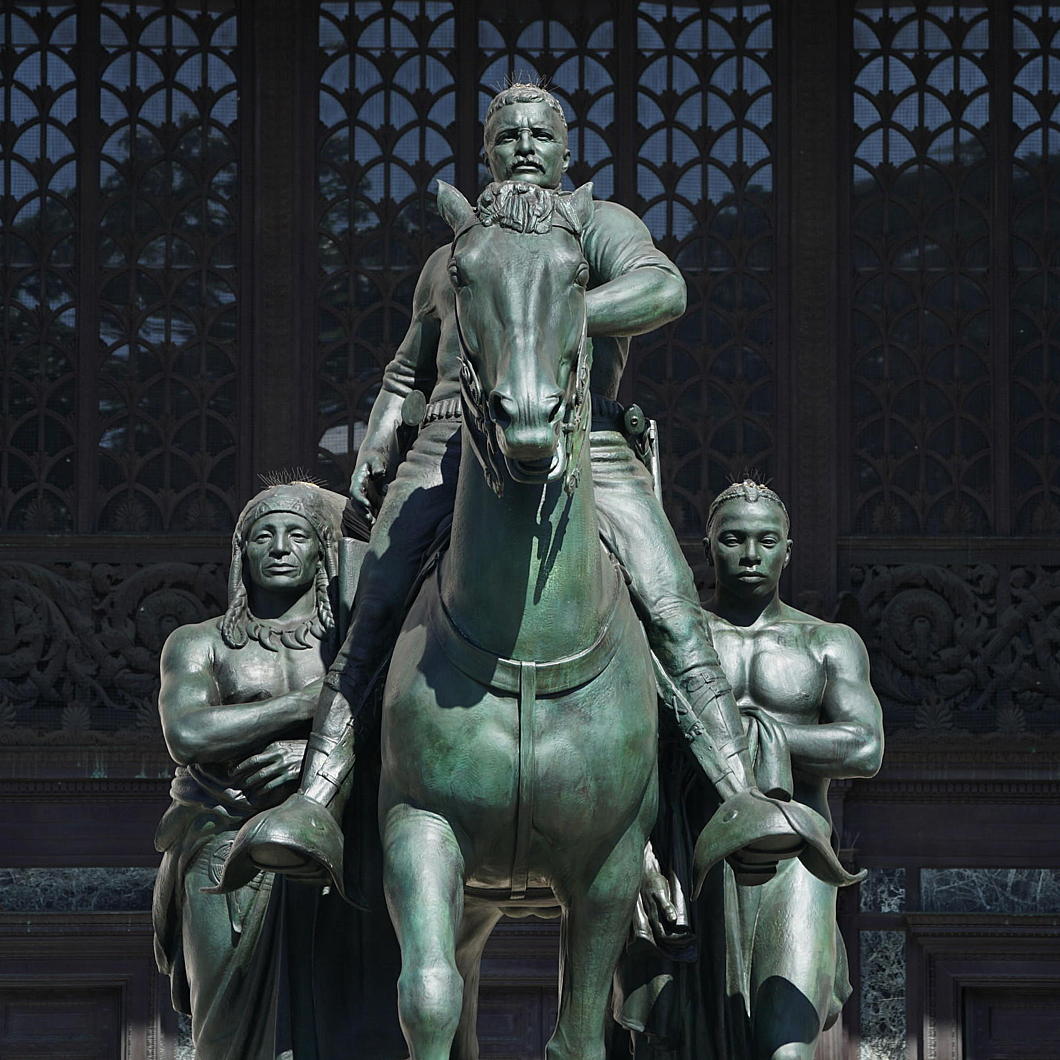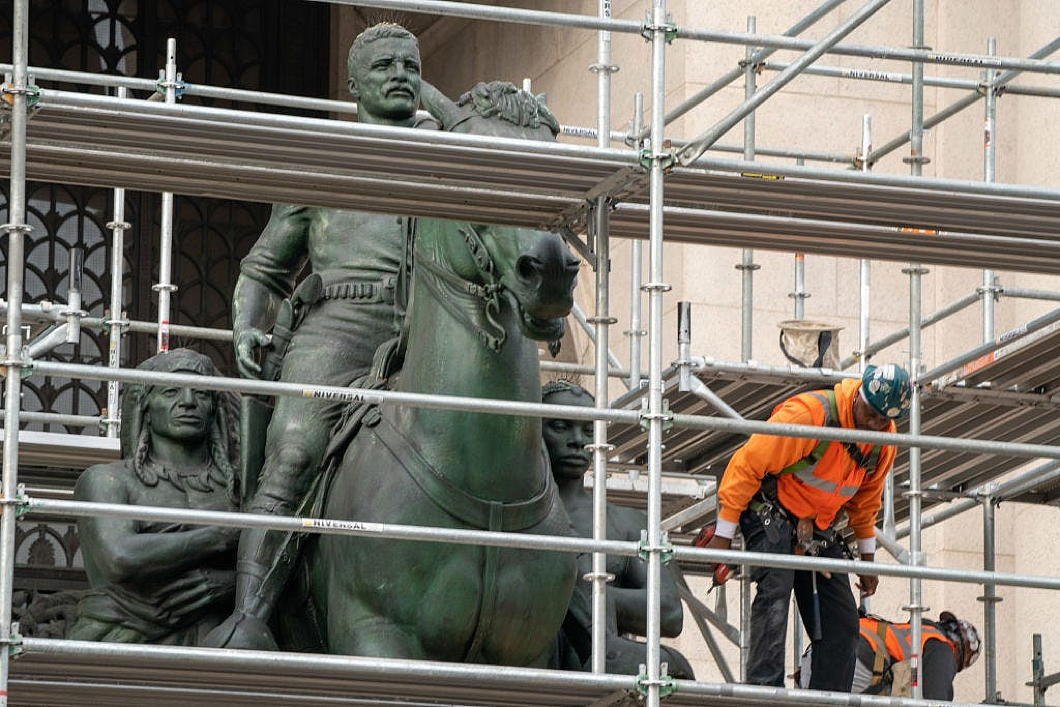
About Andrew Cusack
 Writer, web designer, etc.; born in New York; educated in Argentina, Scotland, and South Africa; now based in London.
Writer, web designer, etc.; born in New York; educated in Argentina, Scotland, and South Africa; now based in London. read more
News
Blogs
Reviews & Periodicals
Arts & Design
World
France
Mitteleuropa
Knickerbockers
Argentina
The Levant
Africa
Cape of Good Hope
Netherlands
Scandinavia
Québec
India
Muscovy
Germany
Academica

Theodore Roosevelt
The ancient heresy of iconoclasm claimed a new victim this week: The statue of Theodore Roosevelt which graced the Manhattan memorial dedicated to him at the American Museum of Natural History has been removed at a cost of two million dollars.
The sculpture had attracted the ire of protestors who objected to the inclusion of a Native American and an African by the side of twenty-sixth President of the United States and sometime Governor of New York, which they claimed glorified colonialism and racism.


While the American Museum of Natural History is a private institution, it sits on land owned by the City, and the statue was paid for by the State.
The statue was doomed in June of last year when the New York City Public Design Commission voted unanimously to rip Teddy down.
As the New York Post put it, “He’s going on a rough ride!”
The statue was severed in two this week, with the top half removed and the bottom half following shortly after.
It will be shipped to the Badlands of North Dakota to be displayed as an object in a museum under construction there.


The 1939 equestrian statue by sculptor James E. Fraser was the central point of the State of New York Memorial to Theodore Roosevelt, including the grand triumphal arch and entrance hall behind the served as the main entry point to the natural history museum.

Roosevelt died in his sleep at Sagamore Hill, Oyster Bay, on the feast of the Epiphany in 1919.
“Death had to take Roosevelt sleeping,” Vice-President Thomas Marshall said, “for if he had been awake, there would have been a fight.”
TR’s son Archibald telegraphed all his siblings: The Old Lion is Dead.

Just two days later, the Senate and Assembly of the State of New York adopted a Joint Resolution:
“Welding into one dynamic personality the rare qualities of aristocracy of both education and training with an all-pervading democracy of both thought and action, uniting the ripe judgment of the scholar and philosopher with the keen foresight of the visionary;
Firm and unyielding to the point of hardness, yet cloaking refusal and rebuke with such evident and overwhelming love for his fellows that they made friends instead of enemies;
Of indomitable will, unconquerable courage and a power of mental and physical endurance that yielded only to his Maker’s demand, Theodore Roosevelt stands preeminently the most lovable, the most versatile, the greatest representative of a great and versatile people.
In his death America has lost a great statesman, a soldier who could either command or obey, an unassuming philanthropist, an undaunted explorer; a beloved leader and wise counsellor and withal an unadulterated American — a man among men.”

The following year the State of New York established a commission to devise and build a permanent structure to act as a permanent memorial to the man who had dedicated so much of his life to the Empire State and its people.
A design by John Russell Pope, one of the pre-eminent architects of the day, was chosen, centring on a large triumphal arch of three bays, with Ionic columns 54 feet high, with the main arch rising 60 feet.
Appropriately, the cornerstone was in 1931 by one of TR’s successors in the state’s executive office: his cousin Governor Franklin Delano Roosevelt.

Roundels depicting the great seals of the United States of America and the State of New York flank the central arch.
Above, a frieze contains the words TRUTH KNOWLEDGE VISION reflecting TR’s character.
In the top central panel, the dedication reads:
THEODORE ROOSEVELT
A GREAT LEADER OF THE YOUTH OF AMERICA
IN ENERGY AND FORTITUDE, IN THE FAITH OF OUR FATHERS
IN DEFENSE OF THE RIGHTS OF THE PEOPLE
IN THE LOVE AND CONSERVATION OF NATURE
AND OF THE BEST IN LIFE AND IN MAN
Elsewhere in the memorial, inscriptions hail Roosevelt’s roles as Ranchman, Scholar, Explorer, Scientist, Conservationist, Naturalist, Statesman, Author, Historian, Humanitarian, Soldier, and Patriot.

By the time the Theodore Roosevelt Memorial was finished his relative Franklin had moved from the State Capitol in Albany to the White House in Washington.
“Race, creed, color, were not determining factors with him,” FDR said at the memorial’s opening ceremony. “He took a man for what he was.”
Theodore Roosevelt Jr — later to die at Normandy and posthumously awarded the Medal of Honor — spoke at the ceremony as well, sharing a story of his father’s time in the White House:
Once, when he was President, he burst in on one of his Cabinet meetings, saying, “Gentlemen, do you know what happened this morning?”
The Cabinet shuddered in anticipation of some earth-shaking calamity.
My father continued, “While I was walking in the garden just now I saw a chestnut-sided warbler — and this is only February.”
“No brick and mortar, no shaft or monument is needed to keep ever fresh the warm affection and regard which Theodore Roosevelt is held in by the people of this state,” Governor Lehman said, “and yet this magnificent building, dedicated to cultural use by the people, is a highly appropriate expression of the deep pride and love of the citizens of the Empire State for one of its great sons.”
How sad that the very men and women appointed to tend the sacred flame and preserve the inheritance of all the people of the state of New York have given in to fear, fashion, and flimflammery, pursuing the path of desecration instead.


PRESIDENT OF THE UNITED STATES OF AMERICA
VICE-PRESIDENT OF THE UNITED STATES OF AMERICA
GOVERNOR OF NEW YORK
NOBEL PEACE PRIZE LAUREATE
FATHER OF THE PANAMA CANAL
MEMBER OF THE STATE ASSEMBLY
COMMISSIONER OF POLICE OF THE CITY OF NEW YORK
ASSISTANT SECRETARY OF THE NAVY
COLONEL, UNITED STATES ARMY
COLONEL, NEW YORK STATE MILITIA
COMMANDING OFFICER, 1ST U.S. VOLUNTEER CAVALRY
LEGUM DOCTOR (COLUMBIA)
ARTIUM BACCALAUREUS (HARVARD)
PRESIDENT, AMERICAN HISTORICAL ASSOCIATION
MEMBER, AMERICAN PHILOSOPHICAL SOCIETY
WRITER, HISTORIAN, CONSERVATIONIST, EXPLORER, NATURALIST, ORNITHOLOGIST, HUNTER, ROWER, BOXER, CATTLE RANCHER, FISHERMAN
NEW YORKER

Search
Instagram: @andcusack
Click here for my Instagram photos.Most Recent Posts
- Sag Harbor Cinema March 26, 2025
- Teutonic Takeover March 10, 2025
- Katalin Bánffy-Jelen, R.I.P. March 3, 2025
- Substack Cusackiensis March 3, 2025
- In the Courts of the Lord February 13, 2025
Most Recent Comments
Book Wishlist
Monthly Archives
Categories



I’m a bit worried about the punditry’s use of ‘iconoclasm’ to refer to contemporary destruction of politically charged images. It implies the rest of us are ‘iconodules’ which is probably rather to their liking. How about we just go with ‘vandals’ and ‘conservatives.’
The vermin swarm.